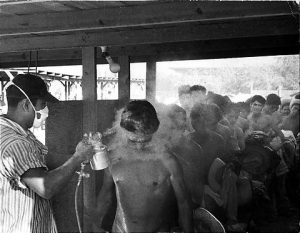Photo by Leonard Nadel
Editor’s Note: The Bracero program addressed the issue of demand for labor and the need for work. It was a cooperative program that allowed America’s work needs to utilize the need of Mexico’s workers’ need for employment. It was legal, it was effective and it was a clear win-win program. Therefore it did not last. Too logical. And here we are now, 52 years later, with America needing workers, Mexicans needing employment and total chaos at the border. One could ask, is this chaos or planned exploitation?
Here is a mini-history of the Bracero Program. Let the discussion begin.
Text by Smithsonian National Museum of American History The Bracero program (1942 through 1964) allowed Mexican nationals to take temporary agricultural work in the United States. Over the program’s 22-year life, more than 4.5 million Mexican nationals were legally contracted for work in the United States (some individuals returned several times on different contracts). Mexican peasants, desperate for cash work, were willing to take jobs at wages scorned by most Americans. The Braceros’ presence had a significant effect on the business of farming and the culture of the United States. The Bracero program fed the circular migration patterns of Mexicans into the U.S.
Several groups concerned over the exploitation of Bracero workers tried to repeal the program. The Fund for the Republic supported Ernesto Galarza’s documentation of the social costs of the Bracero program. Unhappy with the lackluster public response to his report, Strangers in Our Fields, the fund hired magazine photographer Leonard Nadel to produce a glossy picture-story exposé.
Presented here is a selection of Nadel’s photographs of Bracero workers taken in 1956: shttp://s.si.edu/1gRD3VJ for Nadel’s photographs and other resources.

